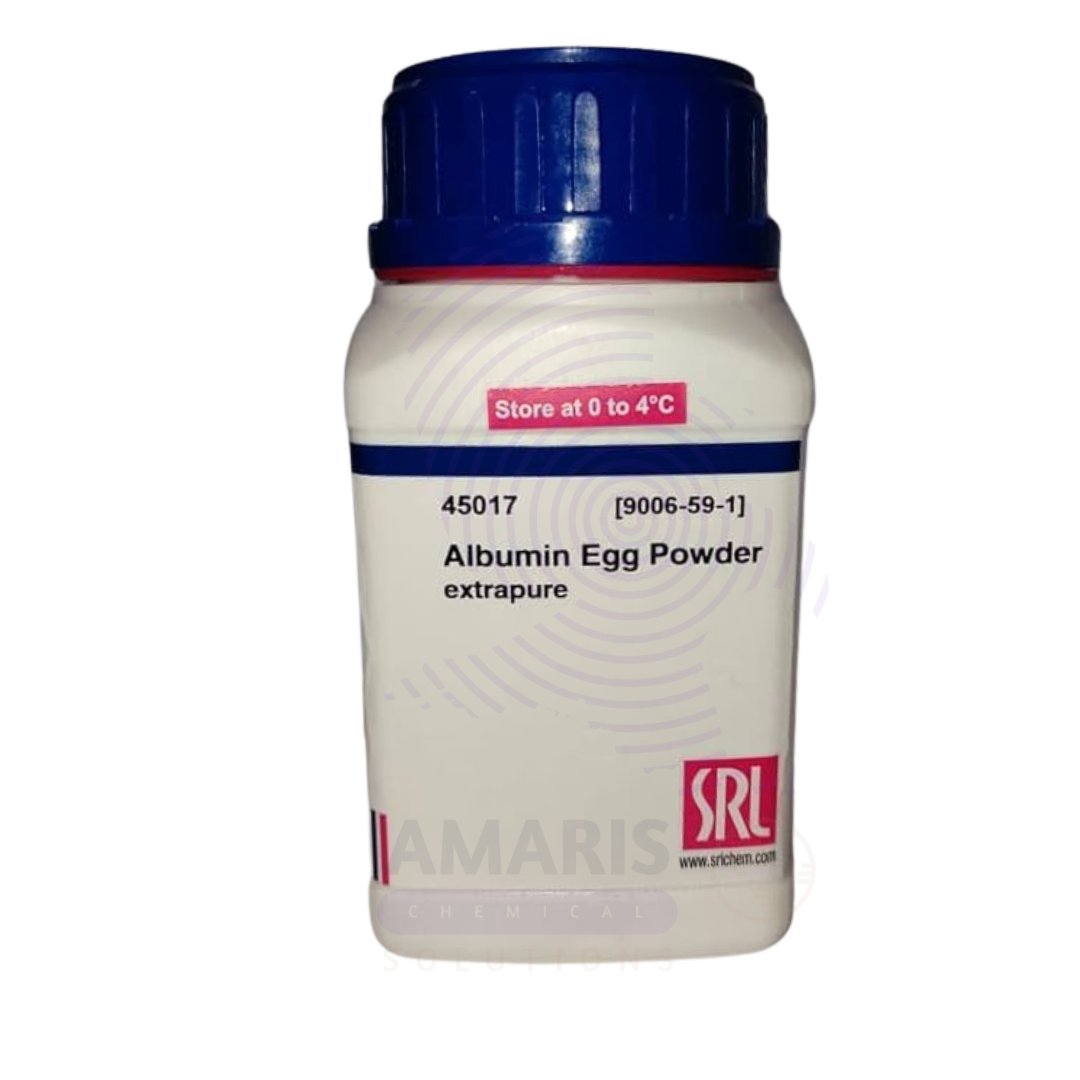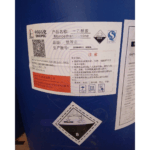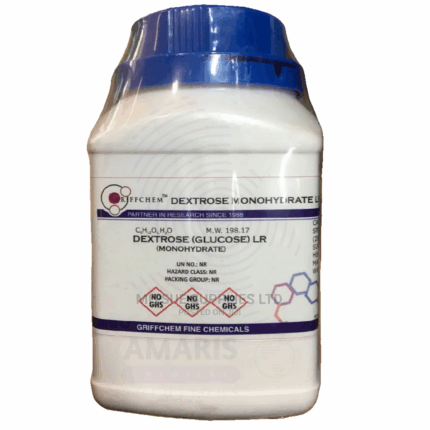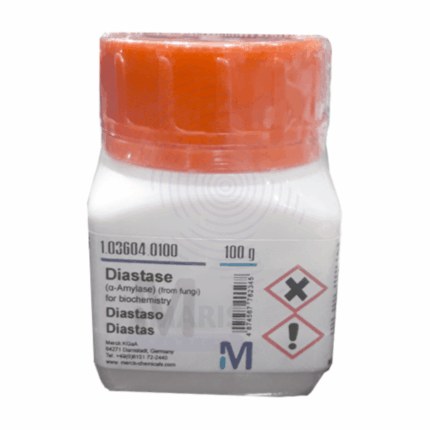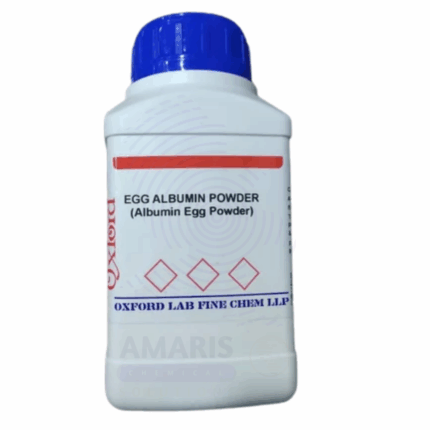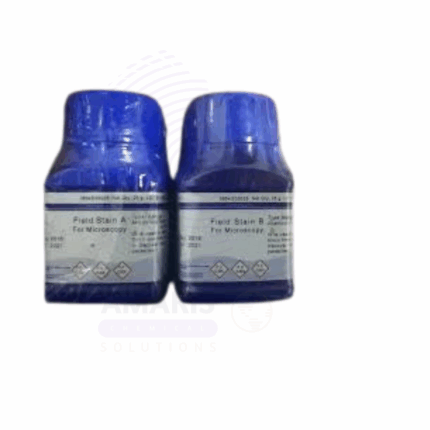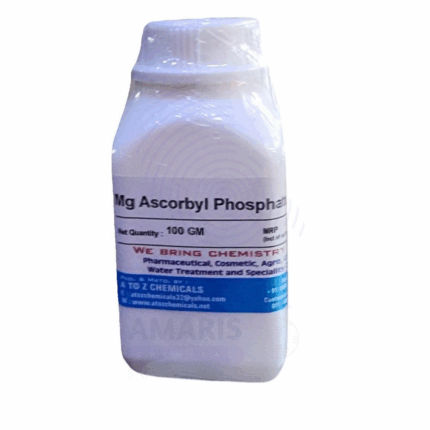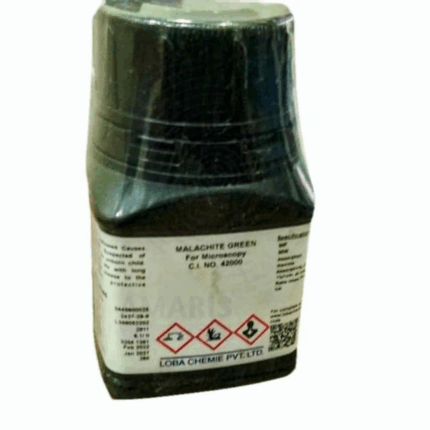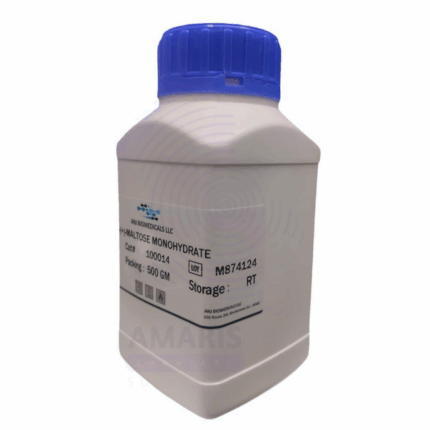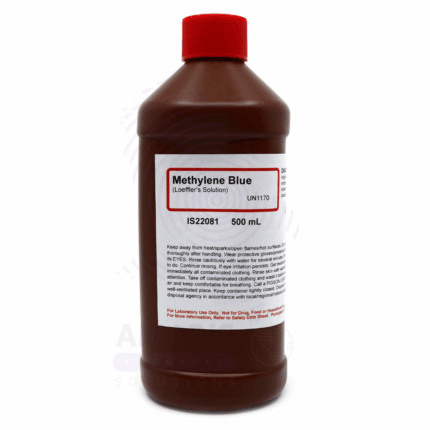

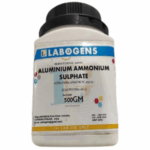
Albumen From Egg Powder Extra Pure
$ 25.00 Original price was: $ 25.00.$ 24.81Current price is: $ 24.81.
Albumen from Egg Powder Extra Pure is a high-purity, finely milled powder derived from the whites of hen eggs, known for its exceptional binding, foaming, and emulsifying properties. This premium-grade product is widely used in biochemical research, microbiological media, and pharmaceutical formulations where high protein content and purity are essential. Its excellent solubility in water and consistent performance make it ideal for applications in diagnostics, nutritional studies, and electrophoresis. In addition, it serves as a reliable protein source in specialized dietary products and laboratory-grade food testing. To preserve its functionality and shelf life, Albumen Powder should be stored in a tightly sealed container, away from moisture and heat.
Albumen From Egg Powder Extra Pure
Primary Uses
- Biochemical & Immunological Research
- Source of high-purity proteins (primarily ovalbumin) for antibody production, ELISA, and other assays.
- Nutrient Media for Microbiology
- Used as a protein supplement in specialized microbial growth media or culture experiments.
- Pharmaceutical & Vaccine Development
- Component in vaccine production platforms or as a stabilizer in biologics.
- Protein Electrophoresis Studies
- Serves as a reference protein for SDS-PAGE or native PAGE analysis.
- Food Science & Quality Control Labs
- Used for testing protein reactions, stability, and foaming properties in food research.
Secondary Uses
- Cosmetic Testing & Formulation R&D
- Tested for its film-forming, tightening, and emulsifying properties in skin-care prototypes.
- Nutritional Research & Formulation
- Used as a controlled protein source in metabolic or dietary studies.
- Biomaterials Research
- Acts as a natural protein matrix in biodegradable film development or tissue scaffolds.
- Educational Use in Protein Chemistry
- Demonstrates protein denaturation, coagulation, and enzymatic reactions in teaching labs.
- Enzyme Studies
- Used to study protease activity and digestion in simulated biological systems.
| PACK SIZE |
25 grams Plastic Tin |
|---|
1. Basic Identification Attributes
- Chemical Name: Albumen (Egg White Powder)
- CAS Number: 9006-59-1
- HS Code: 35021100
- Molecular Formula: Not applicable (complex mixture of proteins, mainly C₄₄₉H₇₀₈N₁₂₄O₁₄₂S₄ for ovalbumin, the major component)
- Synonyms:
- Egg white powder
- Dried albumen
- Egg protein powder
- Powdered egg whites
- Ovalbumin (main protein constituent)
2. Physical & Chemical Properties
- Physical State: Solid (fine powder)
- Color & Odor: White to pale yellow; mild, egg-like odor
- Boiling Point: Not applicable (decomposes before boiling)
- Melting Point: Not applicable (proteins denature and degrade upon heating)
- Density/Specific Gravity: Bulk density ~0.3–0.5 g/cm³
- Solubility:
- Water: Soluble in cold water (forms a viscous solution)
- Organic Solvents: Insoluble
- pH Level: ~7.0–9.0 (in 1% aqueous solution)
- Vapor Pressure & Volatility: Non-volatile
- Flash Point: Not flammable
- Autoignition Temperature: Not applicable
- Viscosity: Forms a viscous colloidal solution when hydrated
3. Safety & Hazard Attributes
- Hazard Class (GHS):
- Not classified as hazardous
- May cause allergic reactions in sensitive individuals (allergenic protein)
- NFPA Ratings:
- Health: 1
- Flammability: 0
- Reactivity: 0
- Exposure Limits:
- No OSHA PEL or ACGIH TLV established
- Use dust control measures to prevent respiratory irritation
- Reactivity:
- Stable under normal conditions
- Decomposes on strong heating; may produce nitrogen and sulfur oxides
4. Storage & Handling Attributes
- Storage Conditions:
- Store in a cool, dry, and well-ventilated area
- Protect from humidity and direct light
- Incompatible Materials:
- Strong oxidizers and acids (may degrade proteins)
- Container Type:
- Sealed food-grade plastic or foil-lined drums, moisture-barrier packaging
- Shelf Life & Expiration Date:
- 2–5 years unopened under dry conditions
- Special Handling Requirements:
- Use dust mask in powder-handling areas
- Avoid contact with moisture before use
5. Regulatory & Compliance Attributes
- Regulatory Status:
- GRAS (Generally Recognized As Safe) by FDA
- Codex & EU food additive approved (used in food, pharma, biotech)
- Allergen labeling required in most jurisdictions (egg protein)
- Hazard Symbols (GHS Pictograms):
- None required unless used in allergen-sensitive processing environments
- Transportation Restrictions:
- Not regulated
- No UN number or special DOT/IMO classifications
- Waste Disposal Method:
- Can be composted or disposed of as food waste
- Follow local bio-organic waste disposal regulations
6. Environmental & Health Impact
- Ecotoxicity:
- Low environmental impact; biodegradable
- Non-toxic to aquatic or terrestrial organisms
- Persistence in Environment:
- Degrades rapidly; not persistent
- Carcinogenicity/Mutagenicity:
- Not classified as carcinogenic or mutagenic
- Biodegradability:
- Completely biodegradable and environmentally safe
SAFETY PRECAUTIONS
- Personal Protective Equipment (PPE):
- Wear protective gloves, lab coat, safety goggles, and a dust mask or respirator (especially when handling large quantities).
- Avoid skin and eye contact and prevent inhalation of dust.
- Handling:
- Handle in a well-ventilated area.
- Avoid creating or inhaling dust.
- Be cautious if allergic to egg proteins—may cause allergic reactions.
- Storage:
- Store in a cool, dry, and well-ventilated place.
- Keep container tightly sealed and away from moisture.
- Protect from pests and microbial contamination.
- Hygiene Measures:
- Wash hands thoroughly after handling.
- Avoid contact with mucous membranes.
- Do not eat, drink, or smoke while handling the powder.
FIRST AID MEASURES
- Inhalation:
- Move to fresh air.
- Rinse mouth and nose with water.
- Seek medical attention if respiratory symptoms occur—especially if allergic.
- Skin Contact:
- Wash with soap and water.
- Remove contaminated clothing.
- Seek medical help if irritation or allergic reaction develops.
- Eye Contact:
- Rinse eyes thoroughly with clean water for at least 15 minutes.
- Lift eyelids occasionally while rinsing.
- Seek medical attention if irritation persists.
- Ingestion:
- Rinse mouth with water.
- Not considered hazardous in small amounts, but seek medical advice if discomfort or allergic symptoms appear.
- If a person is known to have egg allergies, seek immediate medical assistance.
FIRE FIGHTING MEASURES
- Suitable Extinguishing Media:
- Use water spray, dry chemical powder, foam, or carbon dioxide (CO₂).
- Specific Hazards:
- Powdered organic material may form explosive dust-air mixtures.
- Combustion may produce carbon monoxide (CO), carbon dioxide (CO₂), and nitrogen compounds.
- Protective Equipment for Firefighters:
- Wear full protective gear and self-contained breathing apparatus (SCBA).
- Firefighting Instructions:
- Eliminate ignition sources.
- Avoid stirring up dust during firefighting.
- Cool containers exposed to flames with water spray.


 Preservatives(food)
Preservatives(food) Flavor Enhancers
Flavor Enhancers Acidulants
Acidulants Sweeteners
Sweeteners Antioxidants
Antioxidants Colorants(food)
Colorants(food) Nutraceutical Ingredients (food)
Nutraceutical Ingredients (food) Nutrient Supplements
Nutrient Supplements Emulsifiers
Emulsifiers
 Collectors
Collectors Dust Suppressants
Dust Suppressants Explosives and Blasting Agents
Explosives and Blasting Agents Flocculants and Coagulants
Flocculants and Coagulants Frothers
Frothers Leaching Agents
Leaching Agents pH Modifiers
pH Modifiers Precious Metal Extraction Agents
Precious Metal Extraction Agents
 Antioxidants(plastic)
Antioxidants(plastic) Colorants (Pigments, Dyes)
Colorants (Pigments, Dyes) Fillers and Reinforcements
Fillers and Reinforcements Flame Retardants
Flame Retardants Monomers
Monomers Plasticizers
Plasticizers Polymerization Initiators
Polymerization Initiators Stabilizers (UV, Heat)
Stabilizers (UV, Heat)
 Antifoaming Agents
Antifoaming Agents Chelating Agents
Chelating Agents Coagulants and Flocculants
Coagulants and Flocculants Corrosion Inhibitors
Corrosion Inhibitors Disinfectants and Biocides
Disinfectants and Biocides Oxidizing Agents
Oxidizing Agents pH Adjusters
pH Adjusters Scale Inhibitors( water)
Scale Inhibitors( water)
 Antioxidants(cosmetic)
Antioxidants(cosmetic) Emollients
Emollients Fragrances and Essential Oils
Fragrances and Essential Oils Humectants
Humectants Preservatives
Preservatives Surfactants(cosmetic)
Surfactants(cosmetic) Thickeners
Thickeners UV Filters
UV Filters
 Fertilizers
Fertilizers Soil Conditioners
Soil Conditioners Plant Growth Regulators
Plant Growth Regulators Animal Feed Additives
Animal Feed Additives Biostimulants
Biostimulants Pesticides (Herbicides, Insecticides, Fungicides)
Pesticides (Herbicides, Insecticides, Fungicides)
 Active Pharmaceutical Ingredients (APIs)
Active Pharmaceutical Ingredients (APIs) Excipients
Excipients Solvents(pharmaceutical)
Solvents(pharmaceutical) Antibiotics
Antibiotics Antiseptics and Disinfectants
Antiseptics and Disinfectants Vaccine Adjuvants
Vaccine Adjuvants Nutraceutical Ingredients (pharmaceutical)
Nutraceutical Ingredients (pharmaceutical) Analgesics & Antipyretics
Analgesics & Antipyretics
 Analytical Reagents
Analytical Reagents Solvents(lab)
Solvents(lab) Chromatography Chemicals
Chromatography Chemicals Spectroscopy Reagents
Spectroscopy Reagents microbiology-and-cell-culture-reagents
microbiology-and-cell-culture-reagents Molecular Biology Reagents
Molecular Biology Reagents Biochemical Reagents
Biochemical Reagents Inorganic and Organic Standards
Inorganic and Organic Standards Laboratory Safety Chemicals
Laboratory Safety Chemicals Specialty Laboratory Chemicals(Special Laboratory Equipment)
Specialty Laboratory Chemicals(Special Laboratory Equipment)
 Demulsifiers
Demulsifiers Hydraulic Fracturing Fluids
Hydraulic Fracturing Fluids Scale Inhibitors(oil)
Scale Inhibitors(oil) Surfactants(oil)
Surfactants(oil) Drilling Fluids
Drilling Fluids
 Dyes and Pigments
Dyes and Pigments Bleaching Agents
Bleaching Agents Softening Agents
Softening Agents Finishing Agents
Finishing Agents Antistatic Agents
Antistatic Agents
 Admixtures
Admixtures Waterproofing Agents
Waterproofing Agents Sealants and Adhesives
Sealants and Adhesives Curing Compounds
Curing Compounds Concrete Repair Chemicals
Concrete Repair Chemicals Anti-Corrosion Coatings
Anti-Corrosion Coatings
 Surfactants(cleaning)
Surfactants(cleaning) Builders
Builders Enzymes
Enzymes Solvents (Cleaning)
Solvents (Cleaning) Fragrances
Fragrances
 Electronic Chemicals
Electronic Chemicals Catalysts
Catalysts Lubricants
Lubricants Photographic Chemicals
Photographic Chemicals Refrigerants
Refrigerants Automotive chemicals
Automotive chemicals Pyrotechnic Chemicals
Pyrotechnic Chemicals
 Biodegradable Surfactants
Biodegradable Surfactants Bio-based Solvents
Bio-based Solvents Renewable Polymers
Renewable Polymers Carbon Capture Chemicals
Carbon Capture Chemicals Wastewater Treatment Chemicals
Wastewater Treatment Chemicals
 Pigments
Pigments Solvents(paint)
Solvents(paint) Specialty Coatings
Specialty Coatings Binders/Resins
Binders/Resins Additives
Additives Driers
Driers Anti-Corrosion Agents
Anti-Corrosion Agents Functional Coatings
Functional Coatings Application-Specific Coatings
Application-Specific Coatings
 Fresh Herbs
Fresh Herbs Ground Spices
Ground Spices Whole Spices
Whole Spices Spice Blends
Spice Blends Dried Herbs
Dried Herbs
 Leavening Agents
Leavening Agents Dough Conditioners
Dough Conditioners Flour Treatments
Flour Treatments Fat Replacers
Fat Replacers Decoratives
Decoratives Preservatives(baking)
Preservatives(baking)
 Plasticizers & Softeners
Plasticizers & Softeners Reinforcing Agents
Reinforcing Agents Adhesion Promoters
Adhesion Promoters Vulcanizing Agents
Vulcanizing Agents Antidegradants
Antidegradants Blowing Agents
Blowing Agents Fillers & Extenders
Fillers & Extenders Accelerators & Retarders
Accelerators & Retarders
